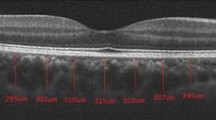Abstract
Purpose
To assess choroidal thickness in patients with lipoid proteinosis versus healthy subjects using enhanced depth imaging optical coherence tomography.
Methods
Twenty eyes of 20 patients and the same number of age and sex-matched healthy individuals were enrolled. Comprehensive ocular examinations including measurement of best-corrected visual acuity, spherical equivalent values of refractive errors, and axial length were performed. Choroidal thickness at three points (subfoveal, 500 µm nasal and temporal regions) were measured automatically using MATLAB software.
Results
The mean age was 15.68 ± 5.98 years in the patient group and 16.48 ± 5.69 years in the control group. Mean choroidal thickness was statistically significantly thicker at each point in patients with lipoid proteinosis compared to the healthy controls: subfoveal, temporal and nasal choroidal thickness measurements were 425.65 ± 51.42, 380.20 ± 69.66, 334.05 ± 49.98 µm in the study group; 346.15 ± 47.76, 330.15 ± 44.35, 298.95 ± 44.21 µm in the control group, respectively (P < 0.05).
Conclusion
Patients with lipoid proteinosis have thicker choroid compared to control eyes. Hyalin deposition and ensuing potential inflammation in the disease process may explain this finding.




Similar content being viewed by others
Data availability
All data generated or analyzed during this study are included in this article.
Code availability
None.
References
Xu W et al (2010) Otolaryngological manifestations and genetic characteristics of lipoid proteinosis. Ann Otol Rhinol Laryngol 119(11):767–771
Urbach E and Wiethe C (1929) Lipoidosis cutis et mucosae. Virchows Archiv fu ̈r Pathologische Anatomie und Physiologie und fu ̈r Klinische Medizin 273: 285–319
Hamada T et al (2002) Lipoid proteinosis maps to 1q21 and is caused by mutations in the extracellular matrix protein 1 gene (ECM1). Hum Mol Genet 11(7):833–840
Goncalves FG et al (2010) Amygdalae and striatum calcification in lipoid proteinosis. AJNR Am J Neuroradiol 31(1):88–90
Kumar P, Sampath V, Manoharan K (2009) Lipoid proteinosis in a child with recurrent respiratory infection. EJ Indian Soc Teledermatol 3:6–11
Lee MY et al (2015) Lipoid proteinosis resulting from a large homozygous deletion affecting part of the ECM1 gene and adjacent long non-coding RNA. Acta Derm Venereol 95(5):608–610
Omrani HG et al (2012) Should we think of Urbach-Wiethe disease in refractory epilepsy? Case report and review of the literature. J Neurol Sci 320(1–2):149–152
Nickla DL, Wallman J (2010) The multifunctional choroid. Prog Retin Eye Res 29(2):144–168
Altinkaynak H et al (2016) Choroidal thickness in patients with systemic lupus erythematosus analyzed by spectral-domain optical coherence tomography. Ocul Immunol Inflamm 24(3):254–260
Coskun E et al (2013) Enhanced depth imaging optical coherence tomography findings in Behcet disease. Ocul Immunol Inflamm 21(6):440–445
Duru N et al (2016) Thinning of choroidal thickness in patients with rheumatoid arthritis unrelated to disease activity. Ocul Immunol Inflamm 24(3):246–253
Spaide RF, Koizumi H, Pozzoni MC (2008) Enhanced depth imaging spectral-domain optical coherence tomography. Am J Ophthalmol 146(4):496–500
Abtahi SM et al (2012) Urbach-wiethe syndrome and the ophthalmologist: review of the literature and introduction of the first instance of bilateral uveitis. Case Rep Med 2012:281516
Sellami D et al (2006) Ophthalmic manifestations of lipoid proteinosis. Presse Med 35(5 Pt 1):796–798
Rosenthal G et al (1997) Carbon dioxide laser treatment for lipoid proteinosis (Urbach-Wiethe syndrome) involving the eyelids. Br J Ophthalmol 81(3):253
Francois J, Bacskulin J, Follmann P (1968) Ocular manifestations of the Urbach-Wiethe syndrome. Hyalitis of the skin and the mucosa. Ophthalmologica 155(6):433–448
Loos E, Kerkhofs L, Laureyns G (2019) Lipoid proteinosis: a rare cause of hoarseness. J Voice 33(2):155–158
Blodi FC, Whinery RD, Hendricks CA (1960) Lipid-proteinosis (Urbach-Wiethe) Involving the Lids. Trans Am Ophthalmol Soc 58:155–166
Callizo M et al (2011) Eyelid lesions in lipoid proteinosis or Urbach-Wiethe disease: case report and review of the literature. Orbit 30(5):242–244
Kim M et al (2013) Choroidal thickness in Behcet’s uveitis: an enhanced depth imaging-optical coherence tomography and its association with angiographic changes. Invest Ophthalmol Vis Sci 54(9):6033–6039
Aksoy M, An I (2020) Evaluation of inflammatory parameters in lipoid proteinosis patients. Dermatol Ther 33(6):e14495
Celik H, Aksoy M, Isa AN, Koyuncu I (2019) The investigation of oxidative stress parameters in patients with lipoid proteinosis. Harran Univ Med Fac 16:1–7
Caramoy A, Heindl LM (2017) Variability of choroidal and retinal thicknesses in healthy eyes using swept-source optical coherence tomography - implications for designing clinical trials. Clin Ophthalmol 11:1835–1839
Ruiz-Moreno JM et al (2013) Macular choroidal thickness in normal pediatric population measured by swept-source optical coherence tomography. Invest Ophthalmol Vis Sci 54(1):353–359
Tan KA et al (2016) State of science: choroidal thickness and systemic health. Surv Ophthalmol 61(5):566–581
Li XQ et al (2014) Subfoveal choroidal thickness in 1323 children aged 11 to 12 years and association with puberty: the Copenhagen child cohort 2000 eye study. Invest Ophthalmol Vis Sci 55(1):550–555
Read SA et al (2013) Choroidal thickness in myopic and nonmyopic children assessed with enhanced depth imaging optical coherence tomography. Invest Ophthalmol Vis Sci 54(12):7578–7586
Gallego-Pinazo R et al (2014) Pachychoroid diseases of the macula. Med Hypothesis Discov Innov Ophthalmol 3(4):111–115
de Carlo TE et al (2015) A review of optical coherence tomography angiography (OCTA). Int J Retin Vitr 1:5
Acknowledgements
The authors would like to thank Dr.Furkan Çiftçi and Engineer Hüseyin Güven Abalı for choroidal thickness measurements and Dr.Elifcan Taşdelen for pedigree figure.
Funding
None.
Author information
Authors and Affiliations
Corresponding author
Ethics declarations
Conflict of interest
None.
Consent to participate
Informed consent was obtained from the participants or their parents.
Consent for publication
Informed consent was obtained from the all authors.
Ethical approval
The study followed the tenets of the Declaration of Helsinki and was approved by the local ethics committee. (Approval number: HRU/20.16.13).
Additional information
Publisher's Note
Springer Nature remains neutral with regard to jurisdictional claims in published maps and institutional affiliations.
Rights and permissions
About this article
Cite this article
Özgür, A., An, İ. Evaluation of choroidal thickness and ocular manifestations in lipoid proteinosis. Int Ophthalmol 43, 239–247 (2023). https://doi.org/10.1007/s10792-022-02422-2
Received:
Accepted:
Published:
Issue Date:
DOI: https://doi.org/10.1007/s10792-022-02422-2




